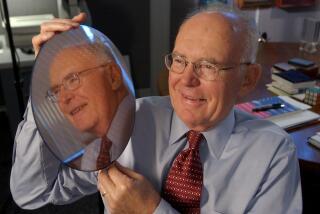Intel Finds Method to Plug ‘Leaky’ PC Chips
- Share via
Intel Corp. said Tuesday that it had figured out how to shrink transistors for PCs so that 1 billion could fit on a single chip, making it possible to pack the power of a supercomputer into a device the size of a deck of cards.
Loading a chip with so many transistors -- Intel’s Pentium 4 microprocessor for personal computers holds about 55 million -- would give it mind-boggling muscle while potentially lowering its price.
For the record:
12:00 a.m. Nov. 24, 2003 For The Record
Los Angeles Times Monday November 24, 2003 Home Edition Main News Part A Page 2 1 inches; 44 words Type of Material: Correction
Intel chips -- An article in the Business section Nov. 5 about an Intel Corp. breakthrough in chip design said researchers had stopped power leakage by replacing a layer of silicon. In fact, the material replaced was a form of silicon called silicon dioxide.
Intel’s breakthrough was in finding new materials to replace silicon in the microscopic gates that control whether a transistor is on or off. With silicon gates as thin as five molecules, as they are in the successor to the Pentium 4, they leak significant amounts of energy. The new materials not only prevent leaks but also enable a transistor to work faster, the Santa Clara, Calif.-based company said.
“It’s as if the construction industry decided that concrete and steel had reached the end of their road and need to be replaced,” said Rob Willoner, a manufacturing technology analyst at Intel, which is the world’s largest chip maker.
Chips built with the silicon-replacement materials would breathe new life into Moore’s Law. Named for Intel co-founder Gordon Moore, it holds that the cost of computing power falls steadily over time.
“We have removed the industry’s most challenging roadblock to ensuring Moore’s Law spans into the next decade, ultimately leading to much lower-cost computing power and enabling applications that cannot be imagined today,” said Ken David, director of Intel’s components research group.
Intel said its researchers replaced the silicon in the gate electrode, which operates like an on-off switch, with a new metal-based material that the company wouldn’t identify for competitive reasons. The new gate will be insulated from the silicon on which transistors are etched with a substance Intel calls High-k for its capacity to hold an electric charge. The company wouldn’t disclose the recipe for High-k either.
Willoner likened a silicon gate to a faucet that drips. The High-k insulation stops the leaks, and that will enable smaller and smaller transistors to be more efficient, he said.
Martin Reynolds, an analyst with the technology market research firm Gartner Inc., said the new chips would be “smaller, faster, cheaper” and would “drive the continuing advance of electronics into our lives.”
Intel believes it can introduce the High-k and metal gate technologies in chips set to hit the market in 2007, when the company plans to introduce a new generation of computer microprocessors. The new technologies shouldn’t add much in cost or entail significant modifications in manufacturing, David said.
With today’s chip technology, the industry is “pushing the edge of being able to do real-time recording of video, one TV channel at a time,” said Steve Kleynhans, an analyst with META Group, a technology industry analysis firm.
“Maybe a billion-transistor microprocessor will be able to record all TV channels simultaneously, in high definition, or produce high-level, unbreakable algorithms for security, or real-time simultaneous translation -- problems that can only be handled by supercomputers today,” Kleynhans said.
Intel shares fell 36 cents to $33.68 in Nasdaq trading.






